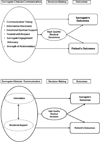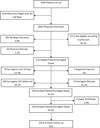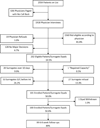Validation of the Family Inpatient Communication Survey
- PMID: 27720790
- PMCID: PMC5191959
- DOI: 10.1016/j.jpainsymman.2016.08.010
Validation of the Family Inpatient Communication Survey
Abstract
Context: Although many family members who make surrogate decisions report problems with communication, there is no validated instrument to accurately measure surrogate/clinician communication for older adults in the acute hospital setting.
Objectives: The objective of this study was to validate a survey of surrogate-rated communication quality in the hospital that would be useful to clinicians, researchers, and health systems.
Methods: After expert review and cognitive interviewing (n = 10 surrogates), we enrolled 350 surrogates (250 development sample and 100 validation sample) of hospitalized adults aged 65 years and older from three hospitals in one metropolitan area. The communication survey and a measure of decision quality were administered within hospital days 3 and 10. Mental health and satisfaction measures were administered six to eight weeks later.
Results: Factor analysis showed support for both one-factor (Total Communication) and two-factor models (Information and Emotional Support). Item reduction led to a final 30-item scale. For the validation sample, internal reliability (Cronbach's alpha) was 0.96 (total), 0.94 (Information), and 0.90 (Emotional Support). Confirmatory factor analysis fit statistics were adequate (one-factor model, comparative fit index = 0.981, root mean square error of approximation = 0.62, weighted root mean square residual = 1.011; two-factor model comparative fit index = 0.984, root mean square error of approximation = 0.055, weighted root mean square residual = 0.930). Total score and subscales showed significant associations with the Decision Conflict Scale (Pearson correlation -0.43, P < 0.001 for total score). Emotional Support was associated with improved mental health outcomes at six to eight weeks, such as anxiety (-0.19 P < 0.001), and Information was associated with satisfaction with the hospital stay (0.49, P < 0.001).
Conclusion: The survey shows high reliability and validity in measuring communication experiences for hospital surrogates. The scale has promise for measurement of communication quality and is predictive of important outcomes, such as surrogate satisfaction and well-being.
Keywords: Communication; decision making; proxy.
Copyright © 2016 American Academy of Hospice and Palliative Medicine. Published by Elsevier Inc. All rights reserved.
Figures
Similar articles
-
The Quick FICS: 5 and 10 Item Versions of the Family Inpatient Communication Survey.J Pain Symptom Manage. 2023 Oct;66(4):e461-e468. doi: 10.1016/j.jpainsymman.2023.06.020. Epub 2023 Jun 19. J Pain Symptom Manage. 2023. PMID: 37343901 Free PMC article. Clinical Trial.
-
Communication Quality Predicts Psychological Well-Being and Satisfaction in Family Surrogates of Hospitalized Older Adults: An Observational Study.J Gen Intern Med. 2018 Mar;33(3):298-304. doi: 10.1007/s11606-017-4222-8. Epub 2017 Nov 28. J Gen Intern Med. 2018. PMID: 29185176 Free PMC article.
-
How to measure experiences of healthcare quality in Denmark among patients with heart disease? The development and psychometric evaluation of a patient-reported instrument.BMJ Open. 2017 Oct 30;7(10):e016234. doi: 10.1136/bmjopen-2017-016234. BMJ Open. 2017. PMID: 29084787 Free PMC article.
-
[French validation of the Verona Service Satisfaction Scale-VSSS-54F].Encephale. 2003 Mar-Apr;29(2):110-8. Encephale. 2003. PMID: 14567162 French.
-
The measurement of patients' expectations for health care: a review and psychometric testing of a measure of patients' expectations.Health Technol Assess. 2012 Jul;16(30):i-xii, 1-509. doi: 10.3310/hta16300. Health Technol Assess. 2012. PMID: 22747798 Review.
Cited by
-
Investigating the Multidomain Impact of Palliative Care on End-of-Life Patients: A Comprehensive Evaluation.ScientificWorldJournal. 2025 Jan 13;2025:4203906. doi: 10.1155/tswj/4203906. eCollection 2025. ScientificWorldJournal. 2025. PMID: 39834752 Free PMC article.
-
Planning Ahead: protocol for a randomised trial of advance care planning for community dwelling older adults at increased mortality risk.BMJ Open. 2025 May 24;15(5):e102186. doi: 10.1136/bmjopen-2025-102186. BMJ Open. 2025. PMID: 40413042 Free PMC article.
-
Factors Associated with Physician Moral Distress Caring for Hospitalized Elderly Patients Needing a Surrogate Decision-maker: a Prospective Study.J Gen Intern Med. 2020 May;35(5):1405-1412. doi: 10.1007/s11606-020-05652-1. Epub 2020 Feb 24. J Gen Intern Med. 2020. PMID: 32096085 Free PMC article.
-
Health Care System Distrust, Race, and Surrogate Decision-Making Regarding Code Status.Health Equity. 2022 Oct 27;6(1):809-818. doi: 10.1089/heq.2022.0044. eCollection 2022. Health Equity. 2022. PMID: 36338803 Free PMC article.
-
The Association of Surrogate Decision Makers' Religious and Spiritual Beliefs With End-of-Life Decisions.J Pain Symptom Manage. 2020 Feb;59(2):261-269. doi: 10.1016/j.jpainsymman.2019.09.006. Epub 2019 Sep 17. J Pain Symptom Manage. 2020. PMID: 31539603 Free PMC article.
References
-
- Baker R, Wu AW, Teno JM, et al. Family satisfaction with end-of-life care in seriously ill hospitalized adults. J Am Geriatr Soc. 2000 May;48(5 Suppl):S61–S69. - PubMed
-
- Abbott KH, Sago JG, Breen CM, Abernethy AP, Tulsky JA. Families looking back: one year after discussion of withdrawal or withholding of life-sustaining support.[see comment] Critical Care Medicine. 2001 Jan;29(1):197–201. - PubMed
-
- Teno JM, Clarridge BR, Casey V, et al. Family perspectives on end-of-life care at the last place of care. JAMA. 2004 Jan 7;291(1):88–93. - PubMed
Publication types
MeSH terms
Grants and funding
LinkOut - more resources
Full Text Sources
Other Literature Sources
Medical






